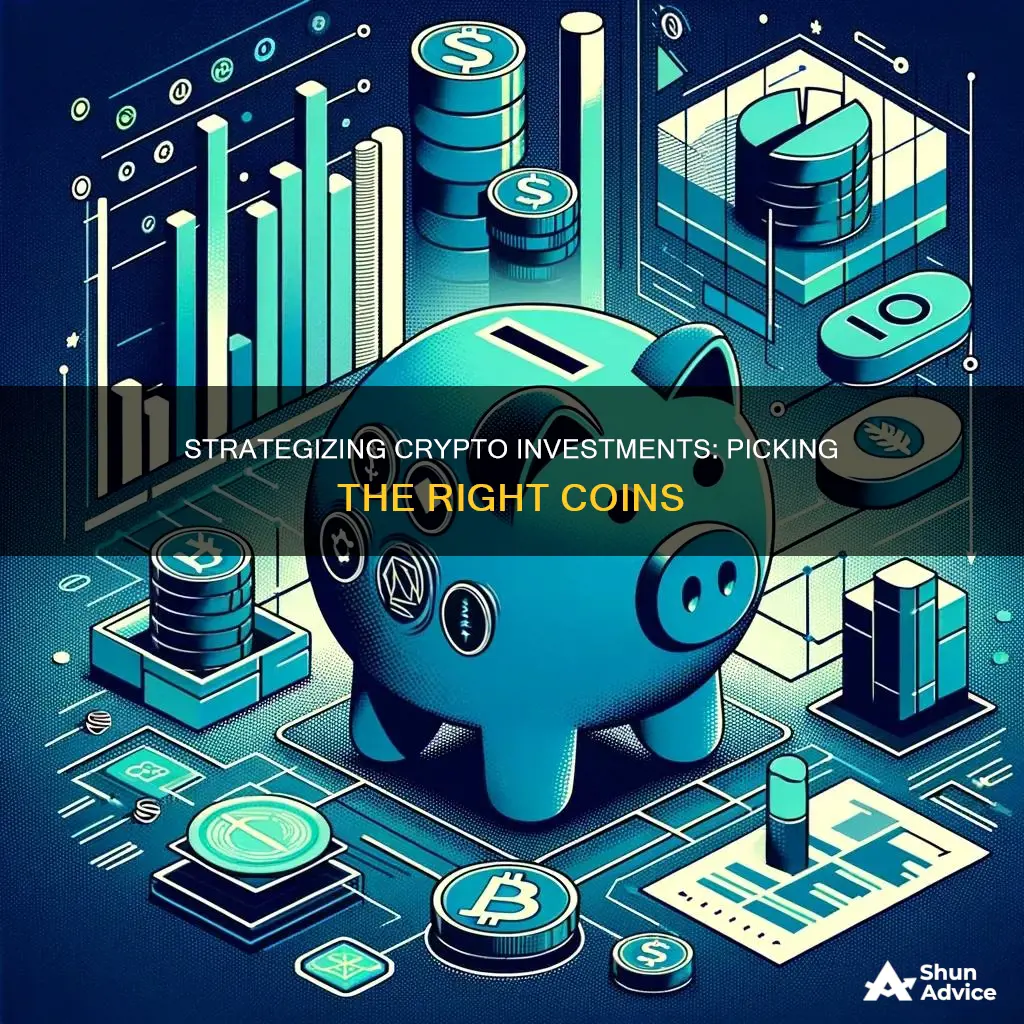
With thousands of cryptocurrencies to choose from, investing in this volatile market is not for the faint-hearted. Before investing, it's important to do your research and understand the foundations of investing. This includes looking at the team behind the cryptocurrency, the revenue model, the technology, and the community.
When deciding which cryptocurrency to invest in, it's crucial to evaluate factors such as revenue, organisation, history, algorithm, and social engagement. It's also important to use a reputable and regulated cryptocurrency exchange and be aware of the fees involved.
Two cryptos that stand out are Bitcoin and Ether, which together represent nearly 70% of the total industry. Bitcoin is often referred to as digital gold due to its utility as a store-of-value asset, while Ether is the native token on the widely used Ethereum blockchain.
Ultimately, investing in cryptocurrencies is a risky endeavour and it's important to understand the fundamentals before making any decisions.
| Characteristics | Values |
|---|---|
| Revenue model or economic impact | Solve some problem or generate money for its ecosystem |
| Organisation | Should be decentralised, but rarely is the case |
| History | Analyse whether the project milestones have been achieved on time |
| Algorithm | Must be proven, secure, and efficient with minimum environmental impact |
| Social engagement | All successful cryptos have a large, vibrant, active, engaged, positive community |
| Credibility | Check for red flags in the white paper |
| Reputation | Check crypto communities and see what people are saying about the coin |
| Security | Go with higher security exchanges |
| Fees | Understand how each exchange and blockchain charge for transactions |
What You'll Learn

Research the team behind the crypto
When deciding which cryptocurrency to invest in, it is crucial to research and evaluate the team behind the project. The calibre and competence of the team can be a powerful predictor of the project's ultimate success. Here are some key considerations when assessing the team behind a cryptocurrency:
Do Your Own Research (DYOR)
Familiarise yourself with the team members by studying their profiles on the project's website, LinkedIn, and other platforms. Look at their work history, educational background, and previous projects. Also, look for proven experience in blockchain or related industries. A team with a deep understanding of blockchain technology and its real-world applications is more likely to steer the project towards success. However, don't underestimate the value of transferable skills and experiences. Past successes in tech projects, even outside the blockchain space, can indicate adaptability and competence.
Track Record and Credibility
Consider the team's previous achievements. Have they successfully launched other crypto projects or built and scaled startups? Evidence of a credible track record can reduce investment risk. Also, look out for any red flags, such as involvement in dubious projects, bad press, or a history of failed ventures. Use reliable sources to assess their professional reputation.
Commitment Level
Commitment to the project can also indicate its potential for success. Teams that work full-time on the project or have a significant stake in the cryptocurrency are likely more dedicated to its long-term prospects. Check if team members have locked their tokens for a specific period, demonstrating their belief in the project. Look for "vesting schedules" in the project's whitepaper or other official documents.
Transparency and Communication
Transparent and effective communication with investors and stakeholders is crucial. Teams that regularly provide updates through various channels, such as blog posts, AMAs, newsletters, and social media, are more likely to be transparent about their operations and progress. Additionally, investigate how the team handles crises or setbacks, as this can be a telling indicator of their character and capacity.
Advisory Board
An experienced and knowledgeable advisory board can add significant value to the project. Advisors provide strategic guidance, industry connections, and validation. Assess the advisory board's credibility and level of involvement in the project.
External Reviews and Audits
Look for external evaluations of the project and its team, such as independent audits of the project's code and security infrastructure. If the team is open to third-party audits, it demonstrates their confidence in their work and commitment to transparency and security. Additionally, seek out expert opinions, reviews, or ratings about the project from crypto-focused forums, blogs, YouTube channels, and podcasts.
The Majority of Bitcoin: Investment or Currency?
You may want to see also

Assess the crypto's revenue model
When it comes to investing in crypto, it's important to understand the various cryptocurrency exchange and revenue business models available. The price of cryptocurrency has been constantly increasing, and this has naturally led to a growing interest in starting a cryptocurrency exchange business.
Initial Exchange Offerings (IEOs)
Initial Exchange Offerings (IEOs) are a type of listing and selling of new coins and tokens. The value of the coin is determined by the coin owner, and the exchange platform charges a fee for showcasing and selling the tokens. IEOs can be a great way for new token/coin owners to sell their coins to users.
Margin Trading and Lending
Volume bots and user bots are used in margin trading and lending. Volume bots are used to increase the trading volume of any pairs, while user bots allow users to utilise the bot to gain profits. The exchange platform charges a fee for each user who subscribes to the crypto exchange platform.
Dynamic Pairing Tools
Dynamic pairing tools help to add and pair ERC20 tokens to the crypto exchange. This feature is especially useful for admin panels that want to add tokens and pair them with desired cryptos without any technical assistance.
Cryptocurrency Trading and Exchange Model
In the cryptocurrency trading and exchange model, every transaction can bring profit. Once your crypto exchange website gains the trust of traders and sees a high volume of trades, your profits will increase.
Cryptocurrency MLM Business Model
The crypto-based MLM business model is gaining popularity and bringing in more revenue. This model combines cryptocurrency with multi-level marketing, allowing businesses to generate revenue from both cryptocurrency exchanges and MLM structures.
Other Revenue Streams
In addition to the models mentioned above, there are other ways that crypto exchange platforms can generate revenue. For example, platforms can charge fees for subscription services, transaction fees, or maintenance of distributed ledgers. They can also offer premium support packages, consulting services, and custom application development for enterprise clients.
Steem Coin: A Beginner's Guide to Investing
You may want to see also

Check the white paper
When deciding which cryptocurrency to invest in, it is important to read the white paper. This document, which is released alongside the launch of a new cryptocurrency, outlines the purpose of the coin, its technology, how it works, and its overall vision. It is important to read this document before investing in a cryptocurrency.
- Clarity and readability: A good white paper should be clear and easy to understand, even for those who are new to cryptocurrency. It should explain the project's objectives and how it plans to achieve them in plain language.
- Technical details: While it is important to understand the technical aspects of the cryptocurrency, be wary if the white paper is overly complex or filled with technical jargon. This could be a sign that the project is not well thought out or is trying to confuse readers.
- The problem being solved: A good white paper should clearly articulate the problem that the project aims to solve and how it plans to do so. Ask yourself if the problem is relevant and if the solution is feasible and needed.
- The need for blockchain: Not every project needs to be built on the blockchain. Be cautious if the white paper claims that the project is a novel use of blockchain technology when it could be achieved through a regular web app or business model.
- Competitive advantages: Look for white papers that discuss the project's unique selling points and how it differs from or improves upon existing solutions.
- Token functions and value: The white paper should clearly state the function and value of the token being offered. What problem does it solve, and why is it needed?
- Design and structure: While content is important, the design and structure of the white paper also matter. A well-designed white paper should be easy to navigate, with a clear table of contents, consistent fonts, and relevant graphic elements that enhance the text.
Remember, a well-articulated white paper is a sign of a well-thought-out project. Take the time to read and understand the white paper before investing in any cryptocurrency.
The Bitcoin Comic: A Guide to Investing
You may want to see also

Understand the pricing history
Understanding the pricing history of a cryptocurrency is essential when deciding whether to invest in it. The price history of a cryptocurrency reflects its evolution and growth over the years. Cryptocurrency has gone through endless changes since its inception, and its pricing history is a testament to that.
By analysing the price history of a cryptocurrency, you can gain insights into its volatile nature. For example, Bitcoin's price history shows a pattern of sharp rises followed by corrections, which is typical of the cryptocurrency market. This volatility is due to the market being heavily influenced by factors such as regulatory announcements, technological advancements, or macroeconomic trends.
Additionally, the pricing history can also indicate periods of stability, which suggest a growing acceptance and use of the cryptocurrency. For instance, Bitcoin's price history shows its transformation from a fringe asset to a mainstream financial instrument. This increased acceptance has attracted institutional investors, hedge funds, and even governments, further boosting its credibility.
The pricing history can also provide a broader overview of the market. For instance, the historical market cap of cryptocurrencies, which reflects the total value of all coins in circulation, can indicate the growth and popularity of the market as a whole.
When examining the pricing history, it is important to look at specific dates and compare them to significant events that may have influenced the price. This can help identify patterns and provide a better understanding of how external factors impact the value.
In summary, understanding the pricing history of a cryptocurrency is crucial when deciding to invest. It provides insights into the volatile nature of the market, indicates growing acceptance, and offers a broader overview of the industry. By analysing specific dates and events, you can make more informed investment decisions.
Explore the Potential: Is 100X Coin Worth Your Investment?
You may want to see also

Evaluate the social engagement
Social engagement is a key factor to consider when choosing which cryptocurrency to invest in. It can be defined as a person's degree of participation in a community or society. In the context of cryptocurrency, this can refer to how interactive people are on social media platforms, such as Twitter, YouTube, and Reddit, as well as group forums like Telegram and Discord.
- Online Communities and Forums: Check out the cryptocurrency's presence on online communities and forums, such as Reddit and Discord. A strong community with loyal followers indicates a genuine interest and belief in the cryptocurrency. These communities are often a great place to understand the hype behind a particular cryptocurrency and get your questions answered.
- Social Media Platforms: Analyze the cryptocurrency's social media presence on platforms like Twitter, YouTube, and Instagram. Look at the frequency of posts and engagement with their audience through comments, likes, and shares. A high level of interaction and a dedicated fan base can indicate a popular and promising cryptocurrency.
- Influencer Engagement: Pay attention to whether any influencers or celebrities are endorsing the cryptocurrency. For example, Elon Musk's tweets about Dogecoin have significantly impacted its value. While this can be a positive sign, be cautious of potential "pump and dump" schemes where influencers artificially inflate the value of a coin before selling it off.
- Social Media Metrics: Utilize tools and platforms, such as Coin Social Story, that provide data metrics on social media engagement for the top cryptocurrencies. These platforms offer insights into Twitter mentions, development activity, social engagement, and trading volume, helping you make more informed investment decisions.
- White Papers: Before investing in a cryptocurrency, read its white paper. This document outlines the purpose of the coin, its technology, how it works, and its overall vision. Evaluating the white paper can give you an idea of the cryptocurrency's professionalism, credibility, and long-term vision. Be wary of unrealistic promises, overly ambitious objectives, and spelling mistakes, as these could be red flags.
- Sentiment Analysis: While this requires more advanced techniques, analyzing the sentiment of social media posts can provide valuable insights. Sentiment analysis tools can help you gauge the overall sentiment towards a cryptocurrency, such as positive, negative, or neutral. This information can be used in conjunction with other factors to make more informed investment decisions.
Gold Coin Investment: Best Buys for Your Money
You may want to see also
Frequently asked questions
It's important to do your research and look into the team behind the crypto. Check their reputation, credibility and relevant experience. Look out for red flags, such as unrealistic promises or spelling mistakes in white papers.
Always look for the physical address of the exchange. Transparency is often a sign of legitimacy. If there is no address, do not use the exchange.
Bitcoin and Ether are the two best cryptocurrencies to buy. They are the most established and have the most mainstream acceptance.
Consider the crypto's revenue model, the organisation behind it, its history, algorithm and social engagement.







